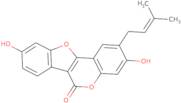
psoralidin
CAS: 18642-23-4
Ref. 3D-FP73918
| 10mg | A consultar | |
| 25mg | A consultar | |
| 50mg | A consultar | |
| 100mg | A consultar | |
| 250mg | A consultar |
Informação sobre produto
- 3,9-Dihydroxy-2-(3-methyl-2-buten-1-yl)-6H-benzofuro[3,2-c][1]benzopyran-6-one
- 3,9-Dihydroxy-2-(3-methyl-2-butenyl)-6H-benzofuro(3,2-c)(1)benzopyran-6-one
- 3,9-Dihydroxy-2-(3-methylbut-2-enyl)-[1]benzofuro[3,2-c]chromen-6-one
- 3,9-dihydroxy-2-(3-methylbut-2-en-1-yl)-6H-[1]benzofuro[3,2-c]chromen-6-one
- 3-Benzofurancarboxylic acid, 2-[2,4-dihydroxy-5-(3-methyl-2-butenyl)phenyl]-6-hydroxy-, δ-lactone
- 6H-Benzofuro(3,2-c)(1)benzopyran-6-one, 3,9-dihydroxy-2-(3-methyl-2-butenyl)-
- 6H-Benzofuro[3,2-c][1]benzopyran-6-one, 3,9-dihydroxy-2-(3-methyl-2-buten-1-yl)-
Psoralidin is a pharmacological agent that induces apoptosis in cancer cells. It binds to the response element of the pro-apoptotic gene, PUMA, and causes the activation of several proteins involved in the apoptosis pathway. It has been shown to successfully induce cell death in HL-60 cells and murine hepatoma cells. Psoralidin is also able to inhibit cancer cell proliferation by suppressing the expression of oncogenes such as MMP-2, MMP-9, and COX-2. The mechanism by which psoralidin induces apoptosis is not yet fully understood but may be due to its ability to induce endoplasmic reticulum stress or activate caspases.
Propriedades químicas
Consulta técnica sobre: 3D-FP73918 psoralidin
Se desejar solicitar um orçamento ou fazer uma encomenda, por favor, adicione os produtos ao seu carrinho e depois solicite um orçamento ou encomenda a partir do carrinho. É mais rápido, mais barato e poderá beneficiar-se dos descontos e outras vantagens disponíveis.





